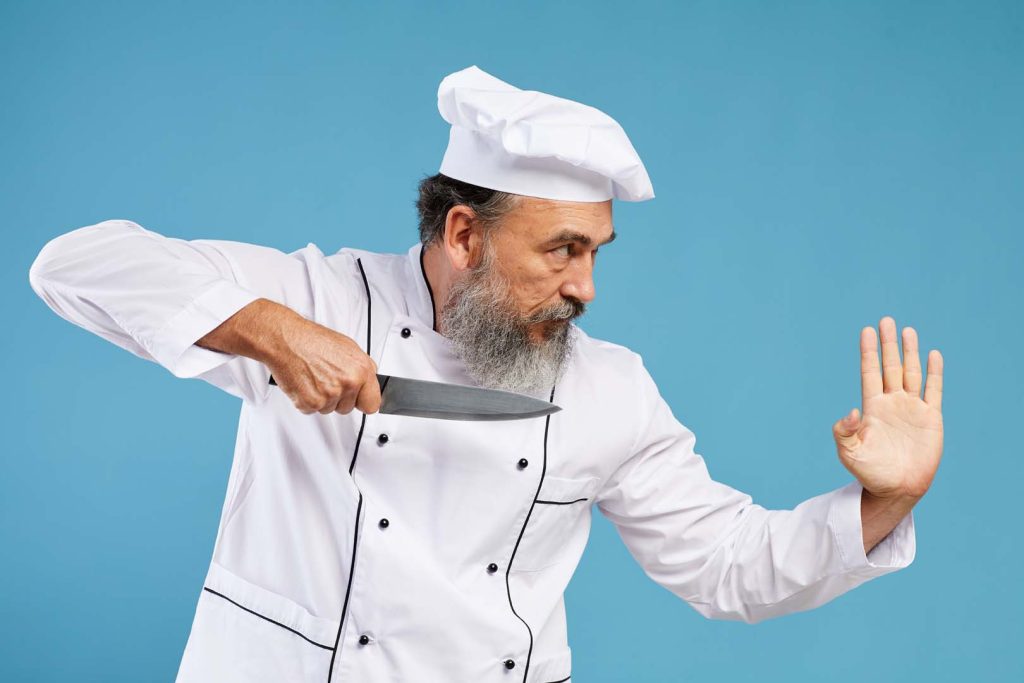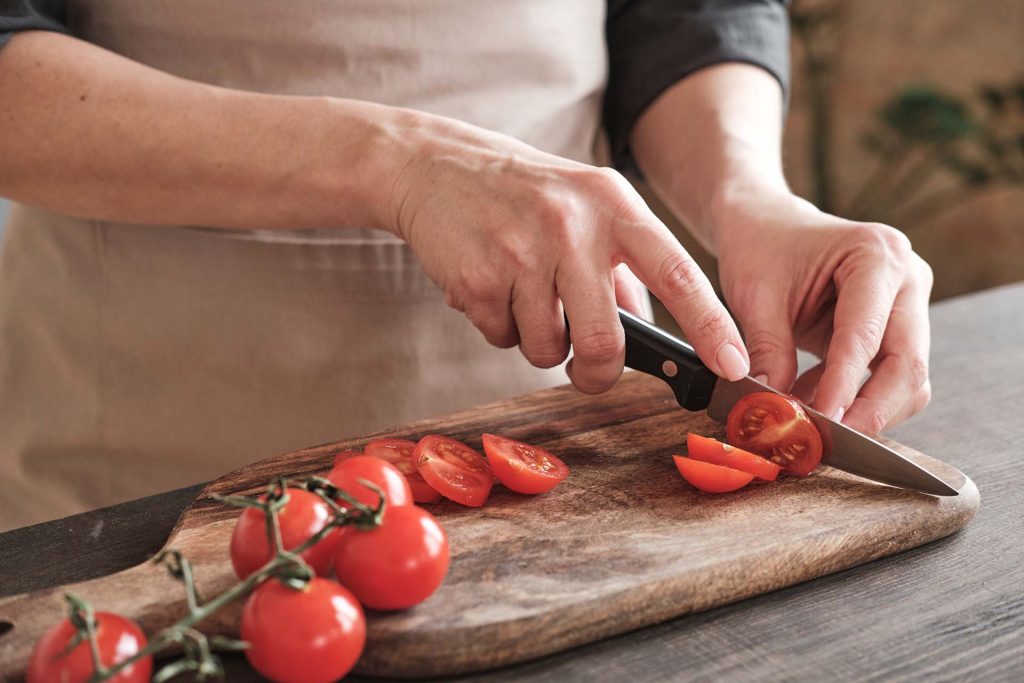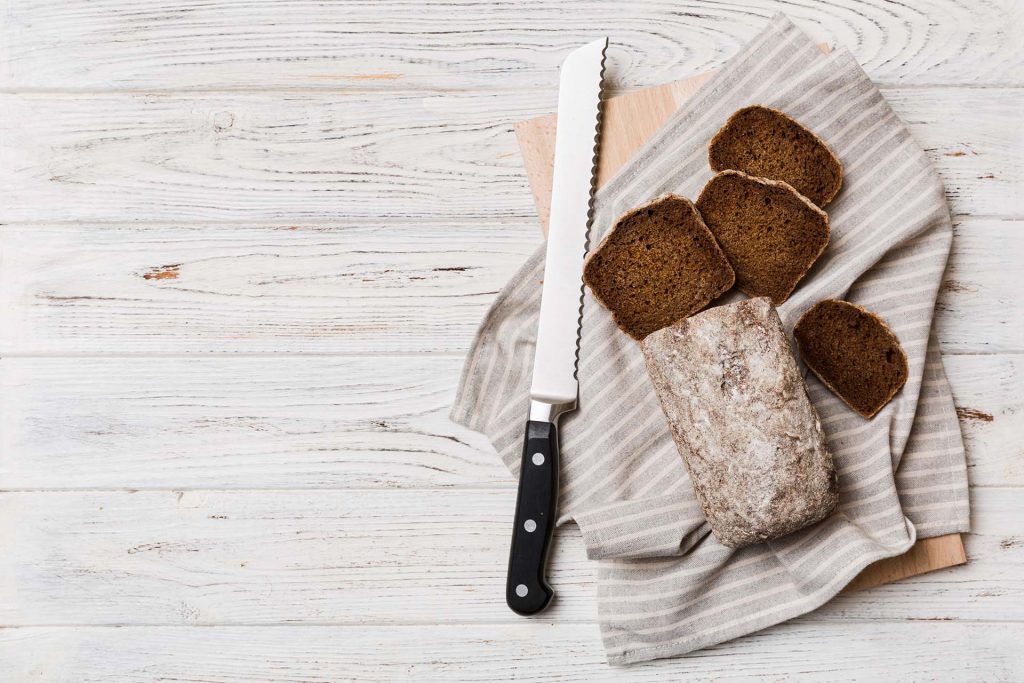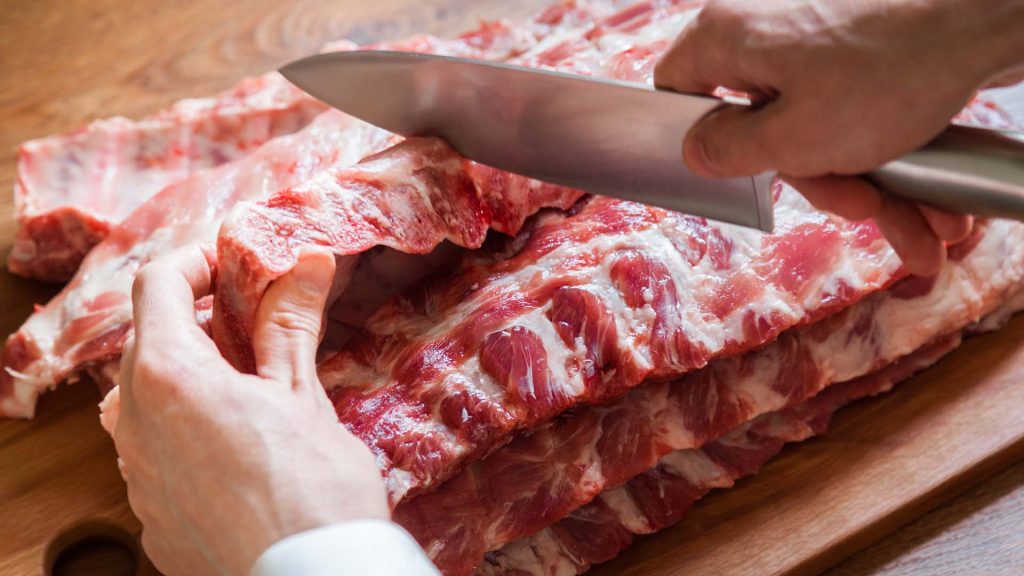I am the kind of person that likes to buy tools before even learning to use them, yes its a character flaw of mine and the older I get the better I seem to control it. So its no surprise I bought an expensive knife kit before I even knew how to cook properly. Did I regret buying it? Absolutely not but It would have been great to know what I need or want from a knife BEFORE buying them.
In my case, I got lucky and got a great first knife set that I have and still am using more than 10 years later. But if you are just considering buying kitchen knifes, then let me share my insight on what I believe are the 5 knives every home cook needs.
The Chef’s Knife: The Workhorse in my Kitchen
If I had to choose only one knife for every task in my kitchen, its would surely be the Chef’s knife. They are versatile and can do most everything, from chopping to slicing, dicing and mincing, no task is too difficult for the chefs knife.
True, there are some tasks that are not as easy with a Chef’s knife such as Peeling and Paring or slicing bread but overall it’s a good tool for many tasks.

Choosing a Chef’s Knife
There are a few factors to consider when choosing a knife, these apply to almost every category in this list so keep them in mind:
- Weight play a crucial role when using a kitchen knife. Think of a knife as an extension of your hand. To light doesn’t feel natural and too heavy is cumbersome find a knife that fits your preferred weight.
- Balance is also very important, a good test is balancing the knife on your index finger at the end point of where you hold it. This will give you the most natural and relaxed feel. Be careful when balancing the knife.
- The Length of a Chef’s knife is between 8 and 10 inches or 20 to 25 centimetres so whatever feels best in that range.
- A Chef’s knife is slightly curved allowing a rocking motion on the cutting board for rapid-fire chopping sessions.
- Steel Quality is a very important factor when choosing your knife, high carbon and a balance between hardness and softness ensure your knife is and stays sharp.
- Asian Style knifes have an ideal sharpness of 58-61 HRC. This range is often found in Japanese-style chef’s knives, such as those from brands like Shun or Global. These knives hold an edge longer and can achieve a finer, sharper edge. However, they require more care to avoid chipping and are a bit more challenging to sharpen.
- 55 – 58 HRC This range is common in Western-style chef’s knives, like those made by Wüsthof or Victorinox. These knives are slightly softer, making them more durable and easier to sharpen but requiring more frequent maintenance.
- If you want to know more about knife sharpening check out my comprehensive guide here
Pro Tip:
Choosing a knife is a very personal choice and what feels good for one person might not be the same for another, you are better off using a cheaper knife for some time until you really know and understand what you want from a knife.
The Paring Knife: Small but Mighty
The paring knife is like the little sibling of the chef’s knife—small, but incredibly useful. Typically about 3 to 4 inches long, it’s perfect for tasks that require precision, such as peeling, coring, and trimming. Whenever I’m prepping fruit or performing delicate tasks like deveining shrimp, my paring knife is my go-to.

Choosing a Paring Knife
Look for a paring knife that feels like an extension of your hand. It should be lightweight, sharp, and easy to control. A straight-edged blade is ideal for precision, while a slightly curved blade can be more versatile for certain tasks.
Certainly! Here are similar bullet points for a paring knife:
- When it comes to Weight & Balance the same principals apply as with the chef’s knife. Find a balance between weight and ensure it balances at the index finger.
- Length: The length of a paring knife typically ranges from 3 to 4 inches (7.5 to 10 cm). Choose a length that feels comfortable and natural for tasks like peeling, coring, and trimming small items.
- Blade Shape: A paring knife usually has a straight, narrow blade, ideal for precision tasks. The blade should allow you to maneuver easily around small and delicate ingredients, providing the control you need for intricate cuts.
- Ideal Hardness for Paring Knives (58-60 HRC): Paring knives with a hardness in the range of 58-60 HRC tend to hold a sharp edge well and are less prone to chipping. This range is often found in high-quality paring knives, providing the sharpness needed for precise tasks while still being relatively easy to sharpen.
- Sharpening Tips: For a paring knife, maintaining a sharp edge is crucial for performing delicate tasks efficiently. Regular honing and occasional sharpening are essential. For detailed guidance, check out my comprehensive knife sharpening guide here.
The Serrated Bread Knife: More Than Just for Bread
A serrated bread knife is a specialist in its field. Its saw-like edge makes it perfect for cutting through foods with tough exteriors and soft interiors, like bread, tomatoes, and even some fruits. Unlike other knives, the serrated edge “grabs” the surface of what you’re cutting, making clean slices without squashing the food.
When selecting a serrated knife, consider the spacing between the serrations. Wider spacing works well for softer items, while closer spacing can handle denser foods. A good serrated knife should be long enough (8 to 10 inches) to handle large loaves of bread or big vegetables.
Pro Tip: Serrated knives are tricky to sharpen at home, so consider investing in a good quality one that will stay sharp for a long time.

The Boning Knife: A Must for Meat Lovers
If you love cooking meat, poultry, or fish, a boning knife is indispensable. This knife, typically 5 to 7 inches long, is designed to remove bones from cuts of meat with precision. It has a narrow, flexible blade that allows you to manoeuvre around bones and cartilage without damaging the meat.
- Weight is just as important when it comes to boning knifes, you should be able to easily manoeuvre the knife around bones and joints so a light knife is more practical than a heavier one. Don’t forget the balance check.
- When it comes to length, 5 to 7 inches or 12 to 18 centimetres is a good choice. Thats long enough to cut through any pieces of meat and small enough to reach difficult areas.
- Blade Tip: The tip of a boning knife is particularly important, as it allows you to pierce through tough sections of meat and navigate around bones. A sharp, pointed tip provides the control and precision needed for tasks like deboning and trimming.
- Sharpening Tips: Keeping a boning knife sharp is crucial for effective deboning and trimming. Regular honing and occasional sharpening will help maintain the knife’s edge. For more detailed advice on knife sharpening, check out my comprehensive guide here.
The Utility Knife: The Jack of All Trades
The utility knife is the jack of all trades in the kitchen, filling the gap between the chef’s knife and the paring knife. It’s typically 4 to 7 inches long and is ideal for tasks that are too big for a paring knife but too small for a chef’s knife. Think slicing sandwiches, cutting small fruits, or even trimming meat.
When selecting a utility knife, versatility is key. Look for a knife that’s sharp and comfortable to hold. It should be lightweight yet sturdy enough to handle a variety of tasks. Consider whether you prefer a straight or slightly serrated edge, depending on what you’ll use it for most.
Pro Tip: A utility knife is great for everyday tasks, but don’t rely on it for heavy-duty chopping or precision work—use the right tool for the job.

So what the conclusion?
Having the right knives in your kitchen is like having the right set of keys—they unlock your full potential as a home cook but you don’t need to spend a fortune on kitchen knifes, fortunately you can get high quality knifes for really good prices. So spend wisely and don’t just throw money on hand made knifes or Damascus steel etc. They might look nice and its ok to buy them if you have the spare money but they are not necessary by any means.
If you are not sure on what knife to get, start with a brand that is affordable but good and once you know what you want from a knife, start exploring higher quality knifes.
Final Tips on Knife Care
Before you go, here are a few quick tips on maintaining your knives:
- Regular Sharpening: Keep your knives sharp with regular honing and occasional professional sharpening.
- Proper Storage: Store your knives in a knife block, magnetic strip, or blade guard to protect the edges.
- Hand Washing: Always hand wash your knives and dry them immediately to prevent rust and damage.
With these five knives and a little care, you’ll be well on your way to mastering the art of cooking. Happy chopping!

